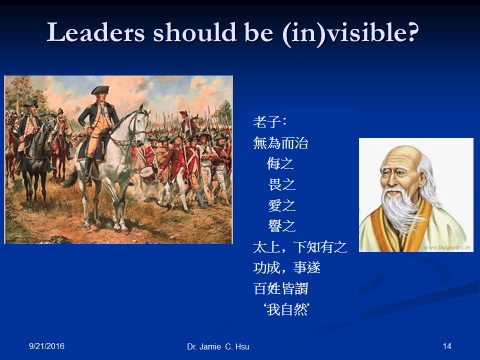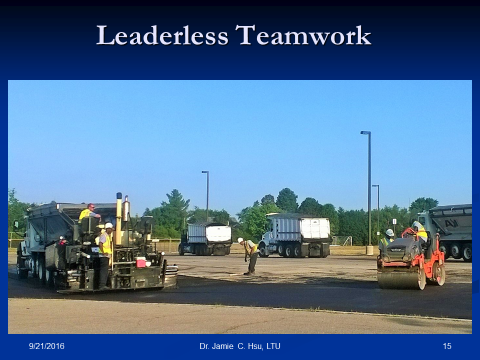
Should Leaders Be Visible or Invisible?
– Musings of Dr. Jamie Hsu, 10.6.2016
In Western cultures and business schools, we are taught that leaders must be visible — to the troops fighting a war or to the frontline employees in a competitive business. Such action will motivate the people, give them courage, respond to their needs, orchestrate their efforts, and give direction as needed. Leaders are encouraged to be seen and heard whenever possible. To reach the goal of being visible, leaders will have all-employee meetings, fireplace chats, brown bag lunches, company retreats, and newsletters. And in this digital age, leaders are present on TV, on Twitter, and in your emails all the time.
On the other hand, the ancient Chinese sage Lao Zi taught us that leaders should be invisible. Lao Zhi categorized leaders into different calibers. The lowest level is the boss whose people despise him and are ashamed to belong to his group. The next lowest is the boss who projects fear in people. The members try to avoid the boss whenever possible. Moving up, we have the leader who is caring, popular and loved by her people. Then there is the leader who has unique capabilities, makes tough decisions, is fair to all, and is respected by the whole team. And ultimately, when the leader develops a great system which allows people to work smoothly in it, hires the right people, and trains people adequately for their jobs, the whole team works together effortlessly. They become so proud of their accomplishments and capabilities, they say, “We did it ourselves — without any leader’s intervention.”
I saw a great example of leaderless performance when a high school parking lot was being paved. There was no supervisor. No one was giving orders. But somehow the trucks showed up with tanks of asphalt, which was loaded into the spreader, compacted by the heavy roller, and manually filled and smoothed. It was like an orchestra performing without a conductor. I was mesmerized by the beautifully orchestrated action under an invisible conducting baton. To have such a performance, there must have been meticulous planning and very experienced and skilled workers.
What is right? Should leaders be visible or invisible? The answer is “Both” and “It depends on the situation.” Leaders need to build the system and develop the people in order to enhance the organization’s “leaderless capability.” Leaders also need to avoid micro-managing and give people enough space to make their mistakes, learn, and grow. A good leader should always try to work herself out of a job, with a system and succession plan in place.
However, when a crisis arises, a leader must be at the scene to calm the nerves, to make tough calls, and to show an example of sacrifice and taking responsibility. You may remember Toyota’s problem with the unintended acceleration crisis and the recall decision. Initially, the CEO used the Eastern leadership style to appoint the most capable engineering head in the company to lead the investigation and come up with corrective solutions. He was using the right people and the well-developed system to solve the crisis. But that did not meet the people’s expectations in the USA. There was a big uproar and people thought the CEO was dodging the issue and his responsibility. Eventually, after two long months, the CEO finally appeared in front of TV and media, made a public apology, accepted the responsibility, and promised to correct the recall problem. A lesson well learned for company leaders.
To be a great leader, let us combine the best of the two worlds of Eastern and Western teaching, and learn the Art of (In)visible leadership.
You might want to start practicing this at home as a parent.


親愛的老闆們,你是顯性派?還是隱性派?
–作者 許俊宸博士
–中譯 薛乃綺
在西方的文化教育中,教導作為領導者應該要是”外顯的”— 像是帶部隊到前線打仗、或是在競爭激烈的商場上與員工衝在第一線。這樣的做法可以激勵下屬、給他們勇氣、回應他們的需求、協調他們的工作、甚至必要時給予他們指導。總之,領導者被鼓勵要儘可能讓員工們看得見、聽得到。為了達到”高能見度”,領導者不得不參加包括全體員工會議、爐邊談話、午餐會議、公司業務會議、會訊等。而身處在這個數位時代,領導者們還會不時出現電視、在Twitter、在員工們的email信箱中。但從另一方面來看,中國古代聖賢老子就教導我們說:
無為而治 , 侮之, 畏之, 愛之, 譽之, 太上, 下知有之, 功成, 事遂, 百姓皆謂 ‘我自然’.
領導者應該是隱形的。老子將領導者按級別分成不同類型:最低層級的領導者,是大家都看不起他、不想成為他的下屬;次低一層級的領導者,是大家都畏懼他、儘可能不要成為他的下屬; 往上一層的領導者,是大家會愛戴他、稱讚他。再往上一層的的領導者是具備獨特的能量、可以做困難的抉擇、做到公正公平、並且受到自己整個團隊的尊敬。最終,當領導者自己發展出一套大體制,在這個體制下,授權給下屬自由發揮、尋找合適的人來執行工作、並為下屬們適當地進行培訓。而下屬們在將來也會為自己的成就與能力感到驕傲,他們會說:沒有老闆的干預,我們靠自己完成了工作!
我曾經看過這種”隱形領導”的好例子。那是在一間高中学校正在鋪設停車場的道路。當時並沒有一個主管在場發號施令,但載著瀝青罐的卡車出現了,它一邊將吊具裝載上去、一邊搭配著滾軸,平順地進行填充道路的工作;就像是一個沒有指揮的樂團一樣,順暢地演奏著。如同無形的指揮棒,我被這樣精美又協調的動作給迷住了!相信要有事先良好的規劃以及熟練經驗的師傅,才能夠有這樣的表現。
不過,到底什麼才是合適的,顯性的領導?隱性的領導?我想答案是兩者皆是,”要視情況而定”。領導者需要建立制度、發展良好的秩序,來強化組織”無領導者的能力”。同時,領導者也需要避免”微觀管理与监视”,要給予下屬足夠的空間去從錯誤中學習、成長。一個好的領導者,應該要儘量设法讓自己能脱離日常事務,而去規劃體制、進行接班人計劃。
然而,當危機出現時,身為領導者必須現身安撫人心、去做艱難的決定、並且能夠犧牲與承擔責任。你也許還記得豐田的‘气车召回’的危機事件。最初,公司CEO採東方人的領導風格,任用一位非常能幹的工程部總負責人來領導整個事件的調查,並提出整頓方案。這位負責人雖然找來合適的人,提出完善的系統制定方法來解決危機,但卻沒能滿足美國消費者的期望。因為人們認為公司的CEO是在迴避問題與責任,這在當時引起很大的騷動。最後兩個月過去了,公司CEO終於出現在電視媒體前,為自己的監督責任公開道歉,並承諾糾正气车召回問題。對於公司領導者來說,這是個很好的機會教育。
整體而言,為了成為一個偉大的領導者,我們應該中西合併、結合兩方的優勢,同時去學習顯性領導與隱性領導這兩門藝術。
也许,你可以试一试在家里对你小孩做如此的領導。


